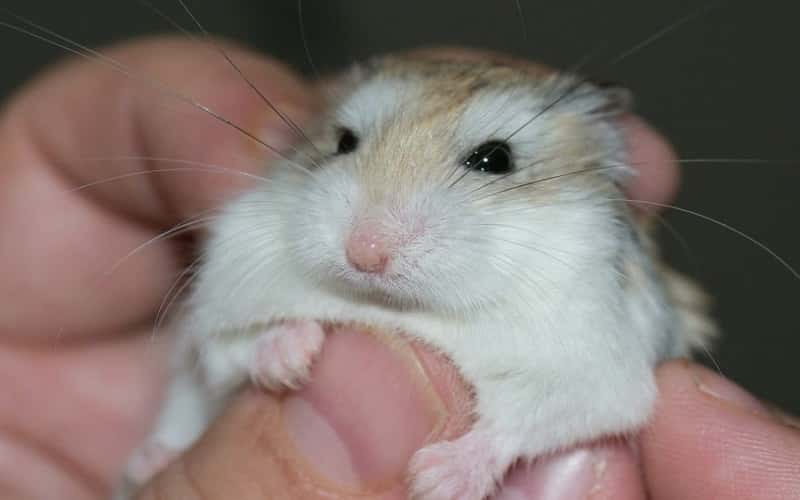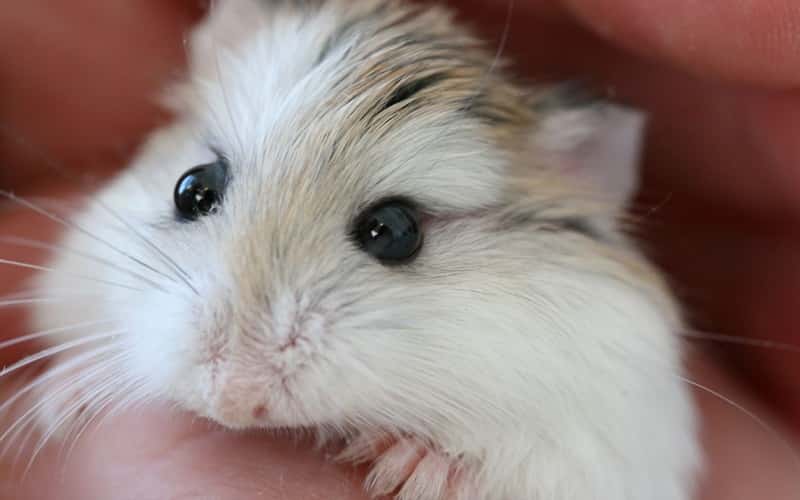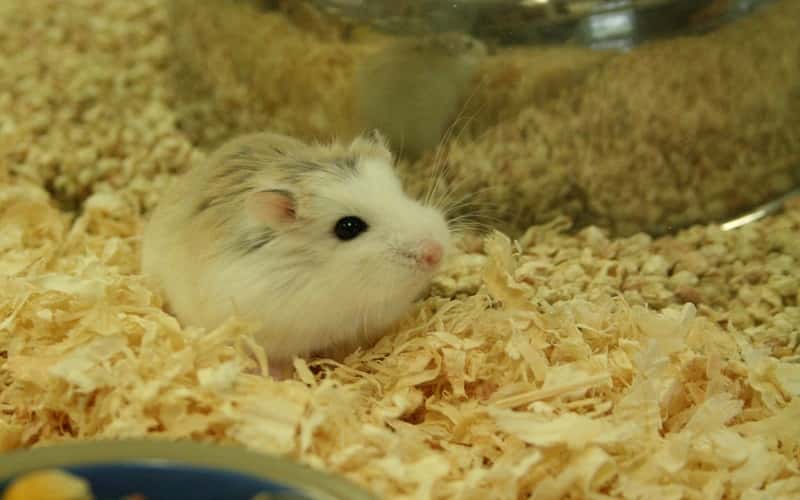Learn about the physical characteristics, habitat, behavior, and temperament of Hamster Roborovski. Discover how to care for them, common health issues, nutrition and feeding requirements, housing and cage setup, breeding and reproduction, grooming and maintenance, lifespan, types, varieties, and colors of hamster Roborovski.
Find out how they compare to other hamster breeds and where to buy them. Explore why Robo hamsters squeak, how to tame them, why they bite their cage, and more.
What is Hamster Roborovski?
A Hamster Roborovski, also known as a Robo hamster, is a small species of hamster native to the deserts of Mongolia and China. They are about 2 inches long, have a tan or grayish-brown fur, and are known for their high level of energy and agility.
Robo hamsters are popular pets due to their small size, cute appearance, and relatively low maintenance requirements. They are primarily nocturnal animals and prefer to live alone in cages with plenty of hiding places, toys, and exercise wheels.
Hamster Roborovski: Origin and History
The Roborovski hamster, also known as the desert hamster, is a small species of hamster that originated in the deserts of Mongolia, China, and Russia. They were first discovered by Russian zoologist Konstantin Alekseevich Satunin in 1903 and were named after his colleague, Lt. Vsevolod Roborovski.
These hamsters were introduced to the pet trade in the mid-1990s, and since then have become a popular choice for small pet enthusiasts due to their small size, active and playful personalities, and relatively easy care requirements. They are generally considered one of the smallest and fastest hamster species, with an average adult length of only 5-6 cm and top speeds of up to 5 mph.
Roborovski hamsters are social creatures and do well living in pairs or small groups, although breeding them in captivity can be challenging. Despite being a popular pet, they are still relatively uncommon in the wild and are considered a vulnerable species due to habitat loss and other environmental factors.

Hamster roborovski
Physical Characteristics of Hamster Roborovski
The physical characteristics of a Roborovski hamster include a small size, typically measuring 4-5cm in length and weighing around 20g. They have short, dense fur that is typically brown or grey on top with a white underside and distinctive white eyebrows.
They have small ears, round eyes, and a short tail. Their front paws have four digits while their hind paws have five, each with sharp claws for digging burrows in the wild. Lastly, they are known for their high energy levels and quick movements.
Habitat and Natural Range of Hamster Roborovski
The Roborovski hamster is a small rodent that is native to the deserts of Central Asia, specifically the regions of Mongolia and northern China. They are adapted to living in arid, sandy habitats and are known for their ability to dig extensive burrow systems.
These burrows provide protection from predators and help regulate body temperature in the extreme temperatures of their natural range. In captivity, Roborovski hamsters require similar conditions, including access to a substrate for digging and hiding, and a temperature range of 65-75°F (18-24°C).
Syrian Hamster Behavior and Temperament
Syrian hamsters are typically solitary and territorial animals. They may become aggressive towards other hamsters if housed together, especially if they are not littermates or introduced at a young age. However, they can be quite friendly and sociable with their human caretakers.
In terms of behavior, Syrian hamsters are nocturnal and tend to be most active at night. They enjoy burrowing, climbing, and exploring their environment. They also have a strong sense of smell and use scent marking as a way to communicate.
As for temperament, Syrian hamsters can vary in personality. Some may be more timid or skittish, while others can be bold and outgoing. They generally do well as pets and can form close bonds with their owners through regular handling and interaction.
It’s important to provide them with a suitable habitat, including bedding material to burrow in and plenty of toys and hiding places to keep them stimulated and happy.
Size of Hamster Roborovski?
The size of a Roborovski hamster is typically around two inches (5 cm) in length and weighs between 0.5 to 1 ounce (15 to 30 grams). They are the smallest breed of hamsters commonly kept as pets.
Hamster Roborovski Care
Hamster Roborovski Care refers to the specific care requirements necessary for maintaining the health and wellbeing of a Roborovski dwarf hamster. This includes providing them with a clean and appropriate living environment, a balanced diet, access to fresh water, and regular exercise opportunities.
Roborovski hamsters also require daily social interaction and stimulation to prevent boredom and stress. Regular veterinary check-ups are also recommended to ensure their overall health and address any medical issues that may arise.
Common Health Issues of Hamster Roborovski
Common health issues of Roborovski hamsters include dental problems, respiratory infections, diarrhea, and wet tail. Dental problems arise from overgrown teeth due to inadequate wear, while respiratory infections can be caused by poor ventilation or exposure to cold temperatures.
Diarrhea may be due to a change in diet or bacterial infection, while wet tail is a severe condition caused by bacteria that affect the digestive system. Signs of illness in Roborovski hamsters include lethargy, loss of appetite, difficulty breathing, diarrhea, and a wet or matted tail. If you notice these symptoms in your hamster, it’s important to seek veterinary care promptly.
Nutrition and Feeding Requirements for Hamster Roborovski
The Roborovski dwarf hamster has a high metabolic rate and requires a diet that is rich in protein, low in fat, and high in complex carbohydrates to maintain optimal health. A nutritionally balanced commercial hamster food can form the basis of their diet, supplemented with fresh fruits and vegetables, such as apples, carrots, and leafy greens.
They also require access to clean, fresh water at all times. In addition to a healthy diet, Roborovski hamsters need a variety of toys and other items to satisfy their active nature and promote mental stimulation.
Housing and Cage Setup for Hamster Roborovski
For a Roborovski hamster, a cage with a minimum of 450 square inches of floor space is recommended. The cage should have good ventilation and be made of materials that are safe for the hamster to chew on, such as wire bars or plastic.
A solid bottom is preferred to prevent bedding from falling out, and the cage should be placed in a location that is cool, dry, and away from direct sunlight and drafts.
The cage should be furnished with a suitable nesting box, toys for enrichment, and a wheel that is at least 6.5 inches in diameter. A layer of bedding material, such as paper-based or aspen shavings, should be added to the bottom of the cage to provide a comfortable surface for the hamster to burrow in.
Overall, the key components of a suitable housing and cage setup for a Roborovski hamster are adequate size, good ventilation, safe materials, suitable furnishings, and appropriate bedding.
Syrian Hamster breeding and Reproduction
Syrian hamsters are capable of breeding at around 3-4 months of age, with a gestation period of approximately 16-18 days. Female hamsters can have litters ranging from 4-12 pups, with an average litter size of 7.
Breeding should be done carefully and responsibly, with appropriate consideration given to the health and temperament of the parent hamsters and the availability of suitable homes for the offspring. It is also important to note that inbreeding can lead to genetic health problems, so it is recommended to avoid breeding closely related hamsters.
Grooming and Maintenance for Hamster Roborovski
Grooming and maintenance for hamster Roborovski involves several essential tasks to keep your pet healthy and happy. Here are some tips:
- Clean their cage regularly: Clean their cage at least once a week, removing any waste, uneaten food, and soiled bedding.
- Provide fresh water: Change the water in their bottle or dish every day.
- Give them a dust bath: Roborovski hamsters enjoy taking dust baths to keep their fur clean and healthy. Provide them with a small container of chinchilla dust to roll around in twice a week.
- Trim their nails: Check their nails every two weeks and trim them if they get too long.
- Brush their fur: Use a soft-bristled brush to groom your Roborovski’s fur once a week. This helps remove any loose hairs and keeps their coat shiny.
- Offer chew toys: Hamsters need to chew to keep their teeth healthy. Provide them with chew toys made of wood or safe materials.
By following these simple grooming and maintenance tips, you can ensure that your Roborovski hamster stays healthy, active, and happy.

Hamster roborovski
Hamster Roborovski Lifespan
The lifespan of a Roborovski hamster is typically around 3-3.5 years, although they can sometimes live up to 4 years with proper care.
How many types of Hamster Roborovski are there?
There is only one type of Roborovski hamster, also known as the desert hamster or Robo dwarf hamster. These small rodents are native to the deserts of central Asia and are popular as pets due to their cute appearance, active nature, and relatively easy care requirements.
While there may be differences in coloration or other physical characteristics among individual Roborovski hamsters, there is only one recognized species of this animal.
Hamster Roborovski as Pets
Hamster Roborovski, also known as the desert hamster, is a small and active species of hamster that makes for an interesting and entertaining pet. They are social creatures that can be kept in same-sex pairs or small groups, but should not be housed with other hamster species.
Roaming around their cages and playing with toys provide them with the needed exercise, and a diet consisting of hamster food, fruits, and vegetables will keep them healthy. They are usually docile and friendly, but may nip if they feel threatened or scared.
Their lifespan ranges from two to three years, and they require minimal grooming. However, their enclosure must be cleaned regularly to prevent health problems.
Overall, Hamster Roborovski can make great pets for those who are willing to provide them with proper care and attention.
Interactions with Other Pets and Humans
Interactions with other pets and humans refer to the way in which animals and people interact with each other. It’s important for pets to have positive interactions with both other animals and humans in order to maintain their physical and mental health.
Positive interactions can include playing, socializing, and spending time together, while negative interactions can lead to fear, stress, and aggression. Proper socialization and training can help ensure that pets interact positively with others, while also keeping humans and other animals safe.
Training and Handling Techniques for Hamster Roborovski
Training and handling techniques for hamster Roborovski involve providing a suitable habitat, proper diet, and gentle socialization to promote their comfort and well-being. Gentle handling is necessary to avoid causing stress or injury to the hamsters.
It is recommended that they be held with both hands, one supporting their body and the other gently holding them in place. Regular cleaning of their habitat and interaction through play activities can also help maintain their health and happiness.
Hamster Roborovski Gender Differences
Roborovski hamsters are one of the smallest species of hamsters, and they have some distinct gender differences. Males are generally larger than females, with a longer body and broader head. They also have more prominent scent glands on their flanks, which they use to mark their territory.
Female Roborovski hamsters have a shorter, rounder body shape, and their heads are more pointed. They do not have the prominent scent glands that males do. Additionally, female Roborovskis have two small openings near their rear end, which are their reproductive organs.
In terms of behavior, male Roborovski hamsters can be more territorial and aggressive towards other males, while female hamsters tend to be more social and less confrontational. Both genders enjoy burrowing and running in wheels, so it is important to provide them with plenty of opportunities for exercise and exploration.
Different Varieties and Colors of Hamster Roborovski
Roborovski hamsters, also known as desert hamsters, are a popular species of small pets. They are known for their fast-running speed and active behavior.
Roborovski hamsters come in different colors such as agouti, husky, albino, and white-face. The agouti color is the most common and has a brownish-grey appearance with a darker stripe down their back. The husky variety has a lighter base color with dark patches on its fur. The albino variety has a white coat with pink eyes, while the white-faced variety has a white face with a darker body.
Aside from the difference in color, there are also variations in the size and appearance of Roborovski hamsters. Some may have longer fur or bigger ears, while others may have shorter fur and smaller ears. These differences can result from selective breeding by breeders or occur naturally within wild populations.
Overall, Roborovski hamsters offer a wide range of variations in color, size, and appearance, making them a popular choice among pet owners.
Comparison of Hamster Roborovski with Other Hamster Breeds
The Roborovski hamster is generally smaller and faster than other hamster breeds, such as Syrian or dwarf hamsters. They also have a distinctive white eyebrow-like marking above their eyes. Unlike some other hamster breeds, Roborovskis are social animals that can be kept in pairs or small groups.
However, they may be more difficult to handle due to their speed and small size. Additionally, Roborovskis have a longer lifespan compared to other hamster breeds, with an average of 3-3.5 years.
How much does a Roborovski Hamster cost?
The cost of a Roborovski Hamster can vary depending on where you purchase it from. On average, they can cost anywhere between $10 to $25. Some factors that may affect the price include the age, gender, and coloration of the hamster. Keep in mind that the initial cost is just one aspect of owning a pet, as there will also be ongoing expenses for food, bedding, and vet care.
Where to buy Roborovski Hamsters?
You can buy Roborovski hamsters at pet stores, either in person or online. You may also find them at breeders or through classified ads online. Make sure to do your research and choose a reputable source to ensure that the hamsters are healthy and well-cared for.
Why is my Hamster Roborovski Squeaking?
Hamsters can squeak for various reasons, including feeling threatened or scared, experiencing pain or discomfort, communicating with other hamsters, or expressing excitement or pleasure. In particular, Roborovski hamsters may make high-pitched noises when they are agitated or annoyed, such as when being handled or disturbed from their sleep.
However, if the squeaking persists or is accompanied by other symptoms, such as lethargy or loss of appetite, it may indicate a health issue that requires veterinary attention.

Hamster roborovski
How to Tame Hamster Roborovski?
To tame a Roborovski hamster, start by spending time near their cage and talking to them softly. Offer them treats from your hand and allow them to come to you at their own pace. Once they are comfortable taking treats from your hand, try gently petting them while they eat.
Gradually increase the amount of time you spend interacting with them each day, and try offering them toys or hiding treats for them to find in order to build trust and playfulness. Avoid sudden movements or loud noises that may frighten them, and be patient as it may take several weeks or even months for them to fully trust you.
Why do Hamster Roborovski Bite Their Cage?
Hamster Roborovski may bite their cage due to a variety of reasons, such as boredom, stress, or dissatisfaction with their living conditions. They may also be gnawing on their cage as a way to maintain their teeth. Providing adequate enrichment and a spacious living environment for your hamster can help reduce the likelihood of them biting their cage.
Why are Robo Hamsters so Mean?
Robo Hamsters, also known as Roborovski dwarf hamsters, have a reputation for being more aggressive than other dwarf hamster breeds. This is because they are very territorial and can be easily frightened by unfamiliar smells or sounds.
Additionally, they are quite fast and active, which can make them difficult to handle and prone to biting if they feel threatened. Proper handling and socialization can help reduce their aggression, but it’s important to remember that their behavior is largely driven by their instincts and natural tendencies.
Why are Robo Hamsters so Fast?
Robo hamsters, also known as Roborovski dwarf hamsters, are naturally fast due to their genetics and physiology. They have a smaller body size than other hamster breeds, which gives them a lighter weight and allows them to move quickly. Additionally, they have a higher metabolic rate, which means they can convert food into energy more efficiently.
Their small size and high energy levels make them agile and able to move quickly in their natural desert habitat where they need to forage for food and avoid predators.
Is a Roborovski Hamster a Russian Hamster?
Yes, a Roborovski Hamster is a type of Russian Hamster. They are also known as Roborovski Dwarf Hamsters and are native to the deserts of Mongolia and northern China, which are close to the Russian border. Despite their name, they are classified as a separate species from other types of Russian Hamsters such as Campbell’s and Winter Whites.
Source: https://petscaretip.com/
